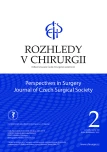Nutrition in open abdomen
Authors:
L. Urbánek; L. Veverková; J. Žák; M. Reška
Authors‘ workplace:
I. chirurgická klinika Lékařské fakulty Masarykovy univerzity a Fakultní nemocnice u svaté Anny v Brně
Published in:
Rozhl. Chir., 2021, roč. 100, č. 2, s. 83-87.
Category:
Case Report
Overview
Open abdomen is known as a serious consequence of various intra-abdominal pathologies. Initially, patients often have a life-threatening condition, sepsis or septic shock. Severe stress related malnutrition, mineral and fluid imbalance develop as metabolic consequences. Intestinal fistulas also occur as a frequent complication in patients with open abdomen. In such patients, a comprehensive approach is needed, including rehabilitation, nutritional support using optimal formulas, and local care for the open abdomen. Our case report presents a patient with open abdomen and enterocutaneous fistulation. A complex nutritional approach in the course of the disease is described and its importance is discussed. Finally, a summary of nutritional care for open abdomen patients is provided based on current recommendations.
Keywords:
open abdomen – nutrition-energy need – protein need
Sources
- Björck M, Bruhin A, Cheatham M, et al. Classification—important step to improve management of patients with an open abdomen. World J Surg. 2009;33(6):1154−1157. doi: 10.1007/s00268-009-9996-3.
- Björck M, Kirkpatrick AW, Cheatham M, et al. Amended classification of the open abdomen. Scand J Surg. 2016;105(1):5−10. doi: 10.1177/1457496916631853.
- Evenson AR, Fischer JE. Current management of enterocutaneous fistula. J Gastrointest Surg. 2006;10(3):455−464. doi: 10.1016/j.gassur.2005.08.001.
- Lloyd DAJ, Gabe SM, Windsor ACJ. Nutrition and management of enterocutaneous fistula. Br J Surg. 2006;93(9):1045−1055. doi: 10.1002/bjs.5396.
- Teixeira PG, Inaba K, Dubose J, et al. Enterocutaneous fistula complicating trauma laparotomy: a major resource burden. Am Surg. 2009;75(1):30−32. doi: 10.1177/000313480907500106.
- Wercka J, Cagol PP, Melo ALM, et al. Epidemiology and outcome of patients with postoperative abdominal fistula. Rev Col Bras Cir. 2016; 43(2):117−123. doi: 10.1590/0100-69912016002008.
- Michelassi F, Stella M, Balestracci T, et al. Incidence, diagnosis, and treatment of enteric and colorectal fistulae in patients with Crohn‘s disease. Ann Surg. 1993;218(5):660−666. doi: 10.1097/00000658-199321850-00012.
- Annibali R, Pietri P. Fistulous complications of Crohn‘s disease. Int Surg. 1992;77(1):19−27.
- Šerclová Z, Ryska O, Dytrych P, et al. Uzávěr stěny břišní po laparostomii s použitím negativního tlaku pro těžkou peritonitidu pomocí dynamické fasciální sutury – výsledky prospektivní randomizované studie. Rozhl Chir. 2012;91(1):26−31.
- Lynch AC, Delaney CP, Senagore AJ, et al. Clinical outcome and factors predictive of recurrence after enterocutaneous fistula surgery. Ann Surg. 2004;240(5):825−831. doi: 10.1097/01.sla.0000143895.17811.e3.
- Collier B, Guillamondegui O, Cotton B, et al. Feeding the open abdomen. JPEN J Parenter Enteral Nutr. 2007;31(5):410−415. doi: 10.1177/0148607107031005410.
- Kumpf VJ, de Aguilar-Nascimento JE, Diaz-Pizarro Graf JI, et al. ASPEN‐FELANPE Clinical Guidelines. JPEN J Parenter Enteral Nutr. 2017;41(1):104−112. doi: 10.1177/0148607116680792.
- Dumas RP, Moore SA, Sims CA. Enterocutaneous fistula: Evidence-based management. Clin Surg. 2017;2 : 1435.
- Klek S, Forbes A, Gabe S, et al. Management of acute intestinal failure: A position paper from the European Society for Clinical Nutrition and Metabolism (ESPEN) Special Interest Group. Clin Nutrition 2016;35(6):1209−1218. doi: 10.1016/j.clnu.2016.04.009.
- Gribovskaja-Rupp I, Melton GB. Enterocutaneous fistula: proven strategies and updates. Clin Colon Rectal Surg. 2016;29(2):130−137. doi: 10.1055/s-0036-1580732.
- Satinský I, Havel E, Bezděk K, et al. Klinická výživa v chirurgii-doporučení ESPEN (European Society for Parenteral and Enteral Nutrition) s konsenzuálním hlasováním pracovní skupiny SKVIMP (Společnost klinické výživy a intenzivní metabolické péče). Anest Intenziv Med. 2019;30(2):104−110.
- Singer P, Berger MM, Van den Berghe G, et al. ESPEN guidelines on parenteral nutrition: intensive care. Clin Nutr. 2009;28(4):387-400. doi: 10.1016/j.clnu.2009.04.024.
- Kudsk KA. Immunonutrition in surgery and critical care. Annu Rev Nutr. 2006; 26 : 463−479. doi: 10.1146/annurev.nutr.26.061505.111230.
- Heyland D, Muscedere J, Wischmeyer PE, et al. A randomized trial of glutamine and antioxidants in critically ill patients. N Engl J Med. 2013;368(16):1489−1497. doi: 10.1056/NEJMoa1212722.
- Badrasawi Manal MH, Shahar S, Sagap I. Nutritional management of enterocutaneous fistula: A retrospective study at a Malaysian university medical center. J Multidiscip Healthc. 2014;7 : 365−370. doi: 10.2147/JMDH.S58752.
- Martinez JL, Bosco-Garate I, Souza-Gallardo LM, et al. Effect of preoperative administration of oral arginine and glutamine in patients with enterocutaneous fistula submitted to definitive surgery: a prospective randomized trial. J Gastrointest Surg. 2020;24(2):426−434. doi: 10.1007/s11605-018-04099-4.
- de Aguilar-Nascimento JE, Caporossi C, Dock-Nascimento DB, et al. Oral glutamine in addition to parenteral nutrition improves mortality and the healing of high-output intestinal fistulas. Nutr Hosp. 2007;22(6):672−676
Labels
Surgery Orthopaedics Trauma surgeryArticle was published in
Perspectives in Surgery

2021 Issue 2
Most read in this issue
-
Perioperative nutrition in the light of guidelines
(and in the shadow of practice) - Intermittent feeding in intensive care – the theory and practice
- Rectal cancer – current treatment strategy and the tumor regression grade evaluation after neoadjuvant therapy in patients who underwent surgery at the I. Department of Surgery, General University Hospital in Prague between 2012 and 2016
- Nutrition in open abdomen
